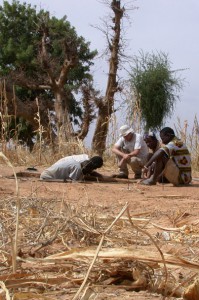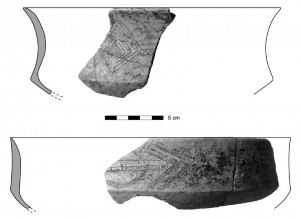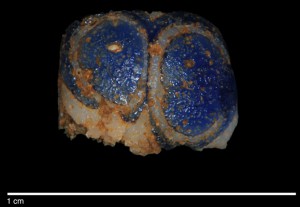A transition period between the Neolithic and the Iron Age, corresponding chronologically to phase 6 of the Holocene at Ounjougou (800-400 BC), can be observed both on the Bandiagara plateau and the Séno plain (see article on the Late Neolithic). Characteristics of the pottery from this phase show general continuity with the Late Neolithic. Covering decoration made by rolled impressions of composite tools with simple or multiple armatures remain common from the plateau to the foot of the escarpment, but apparently more rarely on the Séno plain where we see the appearance of rolled decoration using composite corded tools with multiple armatures to produce a motif organized in two perpendicular axes. This decorative technique, known in the Méma from the start of the 2nd mill. BC, is also attested in southwestern Gourma during the 1st mill. BC.
This transition phase was succeeded by the local Early Iron Age, at present known only in the Séno plain (fig. 1). Its chronological limits need to be clarified, but are currently situated between 500 and 200 BC. From a cultural and technical viewpoint, we note a strong increase in the representation of grog in ceramic pastes, although these are still in majority tempered with quartz. Narrow mouths and everted rims are still minimally present, and we especially see the appearance of keeled pots with incised geometric decoration, sometimes painted (fig. 2). The covering motifs in perpendicular patterns from the preceding phase are still very well represented, with the common practice of polishing the surface. The only evidence of knapped lithic industries associated with the onset of the Iron Age are related to the production of hyaline quartz flakes to make very fine small polished beads (1-2 mm thick), perforated by picking and then percussion. The fabrication of bone points and wedges is also observed.
Associated with this group, two fragments of unidentified objects and a fragment of raw smelting waste constitute the earliest evidence of iron known to date in the Dogon Country. The metal may have been forged nearby, but no evidence of ore smelting associated with this period has as yet been found. The discovery of a glass bead fragment of Mediterranean origin also raises the question of the existence of trans-Saharan trade networks well before the Islamic period (fig. 3).
This Early Iron Age in the Dogon Country is thus characterized by the arrival of new technical and cultural contributions to a local substrate in which some of the final components of the local Late Neolithic persist. The archaeological record for this phase indicates both eastern influences from the Lake Chad Basin and/or northern influences probably related to new migrations from the Sahara and the arrival of more regional traits pointing toward the Méma, the Inland Niger Delta and the southwestern Gourma. The archaeological sequence from the Séno plain is next marked by an archaeological gap of several centuries, which tends to confirm that settlement of the Dogon Country as a whole was disrupted during the Late-Final Holocene transition. While a short period of aridity may have played a role in the transition to the pre-Dogon period, the region was not completely abandoned during the final centuries BC, as shown by the first coiled clay tombs built on the cliff (see article on the burial at Dourou Boro). It thus appears that the arrival of iron in the region was prior to the establishment of the first pre-Dogon groups as they are defined today (see articles on pre-Dogon and Dogon).



